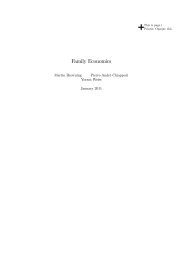The relationship between DSGE and VAR models - cemmap
The relationship between DSGE and VAR models - cemmap
The relationship between DSGE and VAR models - cemmap
Create successful ePaper yourself
Turn your PDF publications into a flip-book with our unique Google optimized e-Paper software.
given model <strong>and</strong> parameterization, but there are many situations in which the formal methods<br />
discussed here are not applicable.<br />
<strong>The</strong> running theme throughout the chapter has been to advocate moving beyond the narrow<br />
question of whether a <strong>DSGE</strong> model can be written as a <strong>VAR</strong>, <strong>and</strong> to focus on underst<strong>and</strong>ing<br />
the impact of the many assumptions <strong>and</strong> arbitrary decisions that underlie the current practice of<br />
estimating <strong>and</strong> validating <strong>DSGE</strong> <strong>models</strong>.<br />
First, the <strong>DSGE</strong> model has to be log-linearized, but the effects of log-linearization have<br />
been scarcely investigated, <strong>and</strong> it might well be that this approximation error will end up dominating<br />
the approximation error from using a nite order <strong>VAR</strong> on which the literature solely<br />
concentrates. More research is needed on this topic.<br />
Second, the log-linearized model is solved <strong>and</strong> multiple solutions are typically ruled out,<br />
again without clear motivation or an underst<strong>and</strong>ing of the effects of this choice on the model<br />
estimates. This is another area that would benet from deeper investigation.<br />
Third, the conclusions depend on which arbitrary choices the researcher makes when bringing<br />
the log-linearized model to the data: the choice of observable variables, whether to drop<br />
observables, add shocks or measurement errors to avoid stochastic singularity, whether to rule<br />
out nonfundamental representations.<br />
Fourth, even if a nite order <strong>VAR</strong> representation exists, the outcome of estimation <strong>and</strong><br />
validation could be severely affected by preliminary data transformations such as demeaning<br />
<strong>and</strong> detrending <strong>and</strong> by the assumptions made about whether the trends are deterministic or<br />
stochastic.<br />
Finally, a choice of benchmark <strong>VAR</strong> model that is purely driven by the initial <strong>DSGE</strong> model<br />
<strong>and</strong> by the selected observables, <strong>and</strong> not by the <strong>VAR</strong> model's ability to t the data, casts doubts<br />
on the validity of the <strong>VAR</strong>'s predictions. It is also not clear why a specic <strong>DSGE</strong> model should<br />
be the starting point of the analysis <strong>and</strong> why <strong>VAR</strong> <strong>models</strong> should be adapted to t a given <strong>DSGE</strong><br />
specication. <strong>DSGE</strong> <strong>models</strong> rely on many arbitrary choices about functional form or market<br />
structure, about the exogeneity of driving processes (such as government spending, productivity<br />
or monetary aggregates) <strong>and</strong> about the dynamic specication of the latent driving shocks. <strong>DSGE</strong><br />
<strong>models</strong> might be rigorous, but they are not necessarily realistic. For example, changing the<br />
21













